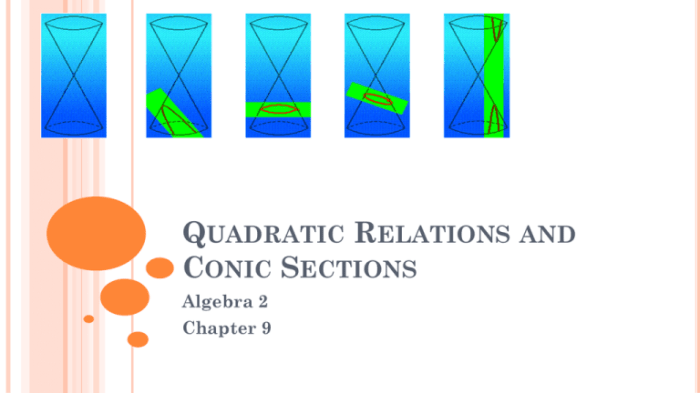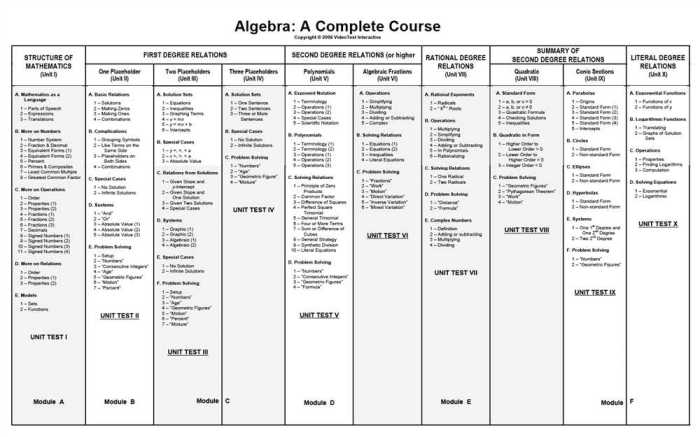Embark on an intellectual journey with Quadratic Relations and Conic Sections Unit Test Part 1, where we delve into the fascinating realm of parabolas, circles, ellipses, and hyperbolas. Discover the intricate connections between these geometric wonders and their applications in the real world, as we unravel their mathematical complexities and practical significance.
In this comprehensive guide, we will explore the fundamental concepts of quadratic relations and conic sections, examining their equations, graphs, and characteristics. We will delve into the techniques for solving quadratic equations and conic sections, uncovering the power of factoring, completing the square, and the quadratic formula.
Quadratic Relations and Conic Sections

Quadratic relations and conic sections are two closely related branches of mathematics that deal with the study of curves. Quadratic relations are equations of the form ax2+ bx + c = 0 , where a, b, and care real numbers.
Conic sections are the curves that are formed when a plane intersects a cone.
Defining Quadratic Relations and Conic Sections
A quadratic relation is an equation that can be written in the form ax2+ bx + c = 0 , where a, b, and care real numbers. The graph of a quadratic relation is a parabola. A conic section is a curve that is formed when a plane intersects a cone.
There are four types of conic sections: circles, ellipses, parabolas, and hyperbolas.
Analyzing Conic Sections, Quadratic relations and conic sections unit test part 1
The different types of conic sections can be identified by their equations. Circles have equations of the form x2+ y 2= r 2, where ris the radius of the circle. Ellipses have equations of the form (x- h) 2/a 2+ (y – k) 2/b 2= 1 , where (h, k)is the center of the ellipse and aand bare the lengths of the semi-major and semi-minor axes, respectively.
Parabolas have equations of the form y = ax2+ bx + c , where a, b, and care real numbers. Hyperbolas have equations of the form (x- h) 2/a 2– (y – k) 2/b 2= 1 , where (h, k)is the center of the hyperbola and aand bare the lengths of the semi-major and semi-minor axes, respectively.
Conic sections have a variety of applications in real-world problems. For example, parabolas are used to model the trajectory of a projectile, and ellipses are used to model the orbits of planets.
Graphing Quadratic Relations and Conic Sections
Quadratic relations and conic sections can be graphed using a variety of methods. One common method is to use the vertex form of the equation. The vertex form of a quadratic relation is y = a(x- h) 2+ k , where (h, k)is the vertex of the parabola.
The vertex form of a conic section is (x- h) 2/a 2± (y – k) 2/b 2= 1 , where (h, k)is the center of the conic section and aand bare the lengths of the semi-major and semi-minor axes, respectively.
Another common method for graphing quadratic relations and conic sections is to use the standard form of the equation. The standard form of a quadratic relation is ax2+ bx + c = 0 . The standard form of a conic section is Ax2+ Bxy + Cy 2+ Dx + Ey + F = 0 .
Solving Quadratic Relations and Conic Sections
Quadratic relations and conic sections can be solved using a variety of methods. One common method for solving quadratic relations is to use the quadratic formula. The quadratic formula is x = (-b ± √(b2– 4ac)) / 2a . Another common method for solving quadratic relations is to use factoring.
Factoring is the process of writing a quadratic relation as a product of two linear factors.
Conic sections can be solved using a variety of algebraic methods. One common method for solving conic sections is to use the completing the square method. The completing the square method is the process of adding and subtracting a constant to a quadratic relation in order to make it a perfect square trinomial.
Another common method for solving conic sections is to use the substitution method. The substitution method is the process of substituting one variable for another in a quadratic relation.
Applications of Quadratic Relations and Conic Sections
Quadratic relations and conic sections have a variety of applications in real-world problems. For example, quadratic relations are used to model the trajectory of a projectile, and ellipses are used to model the orbits of planets. Other applications of quadratic relations and conic sections include:
- Engineering: Quadratic relations and conic sections are used to design bridges, tunnels, and other structures.
- Physics: Quadratic relations and conic sections are used to model the motion of objects, such as projectiles and planets.
- Economics: Quadratic relations and conic sections are used to model supply and demand curves.
Commonly Asked Questions: Quadratic Relations And Conic Sections Unit Test Part 1
What are the different types of conic sections?
Conic sections are classified into four main types: parabolas, circles, ellipses, and hyperbolas. Each type is defined by its unique eccentricity, which determines its shape and properties.
How do you solve quadratic equations?
There are several methods for solving quadratic equations, including factoring, completing the square, and using the quadratic formula. Each method has its own advantages and is suitable for different types of equations.
What are the real-world applications of conic sections?
Conic sections have numerous applications in various fields, such as physics, engineering, and architecture. They are used to model projectile motion, design bridges, and determine satellite orbits, among other practical uses.


